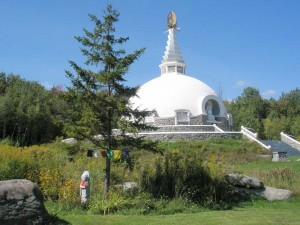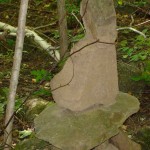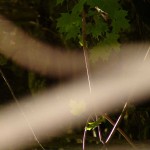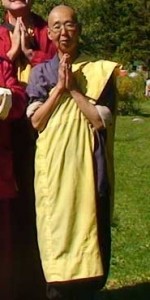The Dharma Propagation Team hiked through the woods to make offerings and pray for world peace and good fortune for all at the Gafton Peace Pagoda (Stupa) near Petersburgh, New York. They found many small stone stupas erected along the trail. One photo taken on this walk also revealed a white translucent light form had joined them on the trail or, more likely, they were traveling through its domain.
The Grafton Peace Pagoda was the result of eight years of voluntary labor and donations from people from all faiths and from many corners of the world. A little Jizo (Kishitagarbha Bodhisattva) with its red bib watches over the pagoda. This stupa was dedicated in 1993 to world peace and specifically the survival of Native Americans. Ven. Jun Yasuda or Jun-san as she is called, the Japanese nun who built the pagoda, had become close to Native Americans. She graciously welcomed us to her small temple and served us lunch in her quarters. She told of her meeting Anishinabe Dennis Banks, the co-founder of the American Indian Movement (AIM), and how she had moved to the Onandaga Reservation in New York state from California to be with his family and support their cause. She told the team how in 1983, she was fasting and praying in Albany on Dennis’s behalf, when she met Hank Hazelton, a long time activist for Native Americans. Hazelton offered her a parcel of land in eastern New York and the Peace Pagoda project began. The Venerable Jun Yasuda, having no heavy equipment, and lacking the strength to use a pick or shovel, began digging the site for the pagoda with a spoon. A local contractor saw this and came and helped, and so it was built, one spoonful at a time.
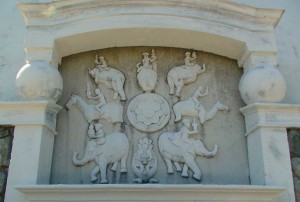
Bas-relief sculpture of the dispersal of Shakyamuni Buddha’s relics in the eight directions from the side of the Peace Pagoda
Ven. Jun Yasuda was just back from her most recent walk across America—The Longest Walk 2—that was organized by her friend Dennis. This is the ninth time she has completed a cross-country walk for peace and the preservation of Native American rights and sacred sites. She was there in 1978 for the first “Longest Walk” as well as at Wounded Knee in South Dakota in minus 80 degree cold at the massacre site for a ceremony called “Wiping the Tears and Mending the Sacred Hoop.” The Lakota gave her the name “Walks Far Woman.”
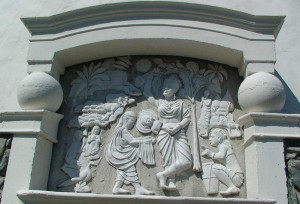
Queen Maya of the Shakya clan giving birth to Prince Gautama in Lumbini, another of the twelve bas-reliefs around the Peace Pagoda.
The Grafton Peace Pagoda enshrines three relics of the Buddha. A Japanese Buddhist, Rev. Nagai, had brought these relics out of Burma during the British occupation and had given them to Ven. Jun Yasuda’s teacher. There are twelve scenes from the life of the Buddha in bas-relief around the sides of the stupa including the conception of the Buddha with Queen Maya dreaming of a white elephant; the birth of the Buddha in the Lumbini garden in Nepal; the Buddha leaving the palace in search of enlightenment; and the dispersal of the Buddha’s relics in the eight directions.

